In our recent Scion Exchange post, I mentioned that we were adding some different apple and crab apple varieties to the orchard. It will be a while before the grafted scions will be ready to plant out in the orchard though.
In the meantime we’ve been adding other fruits to the orchard. Three new bare root trees have been planted this winter. A white peach, an antique apple, and an Asian persimmon.
The peach tree ‘Indian Free’ was special-ordered through a local nursery to ensure we’d have one to plant this season. We have Tom at Tall Clover Farm to thank for pointing out this variety to us. Ever since reading his posts about ‘Indian Free’ here and here, we’ve had a slight touch of peach envy. ‘Indian Free’ is a freestone white peach that is resistant to peach leaf curl (PLC), and tolerant of cool coastal climates. This variety produces beautiful fruit with red skin and crimson-streaked white flesh. I can only imagine how gorgeous our peach preserves will be from this tree!
We instituted the rule of PLC resistant peaches in the orchard before we even installed the orchard fence. After battling PLC, which is caused by Taphrina deformans, rather unsuccessfully in our last garden, only resistant peach varieties are allowed to set root here. We also prefer freestone peaches, especially if they’re going to be used in the kitchen. Clingstone peaches are fine for eating out of hand, but for baking, canning, and jam-making, I find nothing more infuriating than trying to pry persistent pits from stubborn stone fruits. ‘Indian Free’ meets both criteria…and as such, we have high hopes for this tree.
‘Indian Free’ is not self-fertile, and requires a pollenizer. Fortunately though, we already have another PLC resistant yellow peach variety, ‘Frost’, in the orchard which will serve the purpose nicely. Despite setbacks with browsing deer last year, ‘Frost’ still outperformed our expectations for such a young tree, so we’re hopeful that ‘Indian Free’ will do as well for us once it’s established. That said, we won’t allow this tree to set any fruit this year to enable the tree to concentrate on establishing a healthy root system. In the meantime, it’s clear our ‘Frost’ tree is impatient for spring…
The antique apple we’ve chosen to plant this year is ‘Spitzenburg’.
The ‘Spitzenburg’ apple was first discovered in the early 1700’s near Esopus, in New York’s Hudson Valley. It is reputed to have been one of Thomas Jefferson’s favorite dessert apples grown at Monticello.[1,2] Spitzenburg is self sterile, but our other apple tree varieties in the orchard will serve as pollenizers. This is an excellent dual purpose apple, apparently wonderfully flavored eaten fresh, but equally as good as a culinary apple, and also a decent cider apple. Along with our Golden Russet apple, and Humboldt crab apple, it’s likely some ‘Curbstone Valley Cider’ will be in the making once the orchard really begins to produce. That said though, I’m excited to try the Spitzenburg in a homemade apple pie!
Unlike our PLC resistant peaches though, this heirloom apple is not known for being disease-free. Although we have selected mostly disease resistant varieties of fruit that are adapted to our location, the Spitzenburg is a little bit of a gamble. This variety is not overly vigorous in growth habit, or fruit set, and unfortunately, especially during a wet warm spring, can be particularly prone to apple scab (Venturia inaequalis).

Fungal spores that cause apple scab disease (Venturia inaequalis) erupting through the cuticle of a crabapple leaf. Magnified about 1500x (Public Domain Image: Source USDA-ARS)
As such, good orchard hygiene and management will be imperative to help prevent and control any potential outbreaks. However, with its rich history, and favorable culinary qualities, we think it’s worth giving this variety a try.
Our third bare root planted this winter is the persimmon. We initially expected we’d just plant the non-astringent and multipurpose variety ‘Fuyu’. However, in the fall and early winter ‘Fuyu’ fruits are readily available at local farmer’s markets, so we decided to plant something different. We’ve chosen the pollen variant cultivar ‘Chocolate’, also known as Tsurunoko.
Although a pollenizer is not required for ‘Chocolate’ to produce fruit, the presence of a pollenizer changes the characteristics of the fruit significantly. In the presence of a pollenizer, ‘Chocolate’ fruits will contain some seeds, but they’ll also develop a wonderfully sweet, complex, spicy brown flesh reportedly reminiscent of cinnamon in flavor.
If the fruits from ‘Chocolate’ are not pollinated however, the fruit will be seedless, and will remain astringent until fully ripe, more similar to the Hachiya persimmon.
As we’d like to increase the likelihood of pollination we acquired scions from two other Asian persimmon varieties at the Scion Exchange a couple of weeks ago, Izu, and Suruga.
The orchard will be almost completely full once the grafted apples are planted out, so rather than make room for two additional persimmon trees, which can become sizable in age, the scions from ‘Izu’ and ‘Suruga’ will be grafted directly to the ‘Chocolate’ persimmon tree in the next couple of weeks. These additional varieties will also hopefully help to extend our persimmon harvest season.
In addition to these bare root trees, we’ve also added two varieties of rhubarb this winter, ‘Victoria’ and ‘Crimson Cherry’.
The crowns are already throwing up their first stalks and leaves, and the rhubarb should make for some wonderful strawberry-rhubarb pies later this spring!
Also on the new fruit front, another gamble, a blackcurrant. I grew up with blackcurrants in the garden, and am very fond of their unique flavor. However, I’m not sure if our climate will really be optimal for them to grow here, but as we have some room just outside of the vegetable gardens, we thought we’d try the blackcurrant ‘Consort’.
Lastly, we’ve planted some additional cane fruits, including the gold raspberry ‘Anne’, the popular red raspberry ‘Meeker’, and our personal favorite, Olallieberries!
With our new bare root fruit trees planted out, our next orchard task is grafting our apple and crab apple scions to their M-111 root stocks…just as soon as the rest of our grafting supplies arrive!
Are you planting any new fruits this season?
—————-
[1] Thomas Jefferson’s Monticello, By Thomas Jefferson Foundation Inc., 2002
[2] The Fruit and Fruit Trees of Monticello, by Peter J. Hatch, 1998

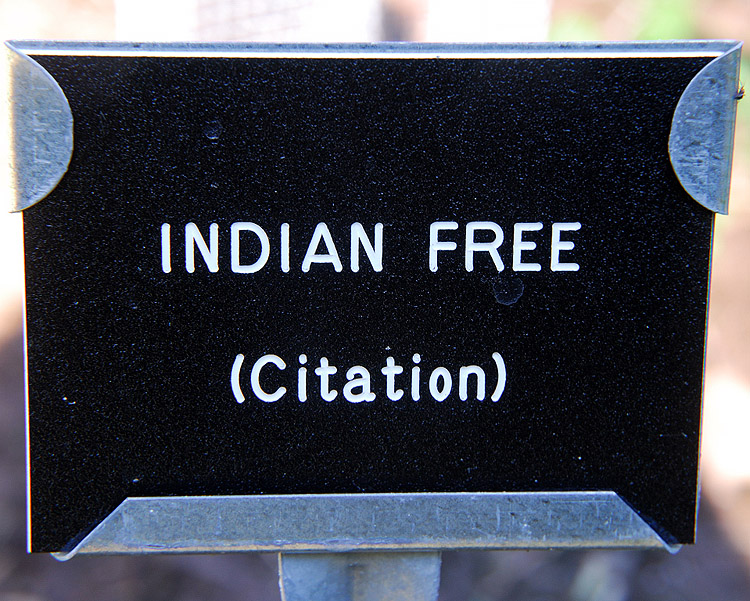
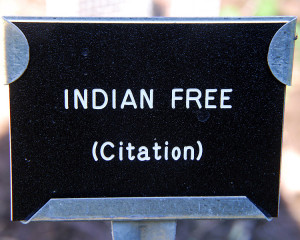
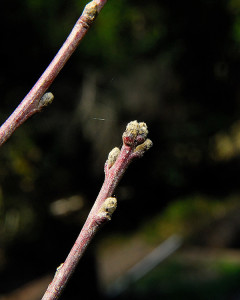

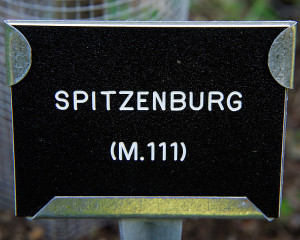
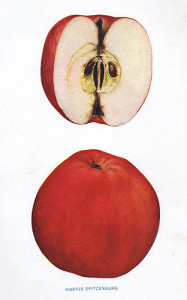
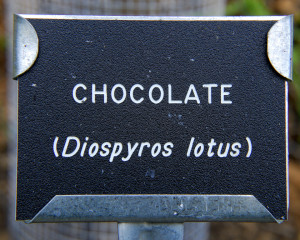
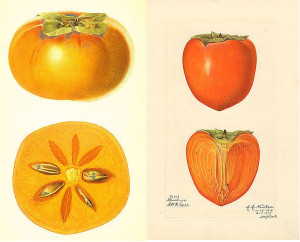

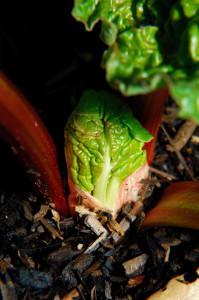

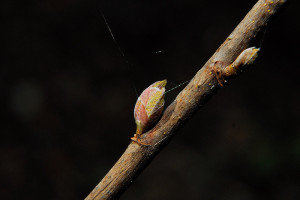
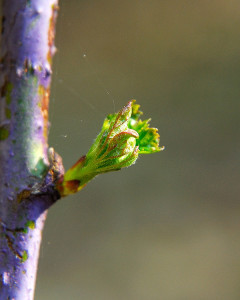







Good reading here I learned a lot. This yard in Durham has the large persimmons and I tried to eat one it was bad, like the native persimmons before they are ready.
Sounds like it was an astringent variety like Hachiya. They almost need to be of a pudding consistency before they’re good. Certainly an advantage of non-astringent persimmons, in that they can be eaten while the flesh is still firm, without tasting ‘bad’.
I agree with Randy, good reading and I always learn something new here.
Oh, that sounds so wonderful! I can already taste it. I had chocolate persimmon at the farmer’s market once and it was very pleasant, though the color was disturbing to many. Apples turn brown when they start to go bad, so a brown persimmon was greeted with some suspicion.
I’ll be curious what your Spitzenberg will do. I planted one as well, and any advice is welcome.
I agree, the flesh color of Chocolate is a little strange! We’re hoping the flavor is worth it though.
I’m curious about Spitzenburg too. For all of the positive articles I’ve read about flavor, I’ve read as many negative articles about performance in the orchard. Good news is, we won’t be lacking on fruit regardless. Just hoping it does modestly well here. Will be fun to compare notes!
Your orchard is going to be huge! Will you keep all the fruit or do you share/sell it? The peach sounds really good. I wonder how it would do here? My friend has a variety that’s supposed to do well here, but they still haven’t gotten fruit from it after several years.
Our apple tree gets worms every year and I’m wondering what type of organic treatment you use to prevent pest problems. If I’m right now’s the time to do something preventative.
When the orchard really gets rolling, we’ll sell some, share some, and the excess will be donated to a local organization called ‘Village Harvest’. They pick the extra fruit in your orchard, and either distribute the fruit to local food banks, or make preserves and sell them to raise money for food banks.
I expect this peach may be alright where you are. I’m not sure exactly where you are, but Tom is growing it successfully on Vashon Island, just north of Tacoma. Worth looking into!
Now I have orchard envy. Here’s to your first jar of peach preserves. In my climate, the Indian Free ripens in early October. When close to ripeness you can pick them and they will ripen nicely off the tree. The skin is so wonderfully tough (in a good way) that it doesn’t seem to split in the rain and insects have a tough time getting through it.
I have a chocolate persimmon tree but it has yet to produce. It is gorgeous, has stunning fall color, and rich green tropical looking leaves. The tree itself is well-mannered and very ornamental. I think I should get persimmons from it this year, it’s fourth.
I’m excited that this is a late harvest peach. Frost is relatively early, so with Indian Free we’ll extend our peach harvest.
Crossing my fingers you get your first persimmons this year. I’ve read they can be slow to come into fruit.
Clare, Your orchard is starting off nicely! Great selection of other fruit too. Persimmons! Yummy! Those are great labels . . . looks like they will last for many years. If only I had used something as permanent, I would not have forgotten varieties. I am drooling over your new shoot of green life! Your rhubarb and strawberries . . . the last photo of your olallieberries is amazing! What colors! I do not know this berry. Happy gardening to you!
The labels were a must. The aluminum tags we have on the trees are fine for the first year or two, but eventually winds usually tear them off the branches. I’m already having trouble remembering what we planted where. The larger tags are great, and they should last a long time. The best part is I don’t have to squint, or rummage through branches to know which tree I’m about to prune!
We’re excited about the olalliberry, they grow very well here in Santa Cruz county. They look like a giant blackberry. They’re a cross between a loganberry and the youngberry. The color in the photo though is mainly from the purple paint on the cane that the nursery used to identify it. That’ll wear off soon 😉
Your orchard sounds fantastic! I hope your antique apple does well; it sounds delicious. I am eagerly waiting to see how my fuyu persimmon does. They are not commonly available here, so it will be a real treat. I also want to plant a fig tree. I’m thinking about putting one in a large pot on our patio. I didn’t think I liked figs till I tasted a freshly picked one a few years ago; yummy! I also have some kumquat seeds from fruit picked off a shrub on my recent trip to Seaside, Florida. I am going to see if these will grow here.
I think you picked a great persimmon Deb. If it wasn’t for the fact they’re so common here at the local markets, I would have planted Fuyu just for its versatility. I don’t have the patience to wait for Hachiyas to ripen, and once they’re soft enough to be ripe, it limits their use in the kitchen. I like to chop up a Fuyu or two and add it a cranberry relish at the holidays…it’s not the same with Hachiya though!
There are so many wonderful fruits listed in this post, I wonder what you will do with it all once the trees really start producing? So glad to see a heritage variety listed. I know they don’t have the wonderful resistant qualities of newer varieties but they have such unique flavour and characteristics that I love to see preserved.
I do see lots of pies, preserves, and cider in our future 😛 We’re looking forward to sharing fruit from our orchard though.
I love, love LOVE Persimmons. I have one that is just a 2′ tall whip… will be many a year before that one is producing. When we get our deer fencing up, I’ll head over to Rainy Side Gardens nursery and grab a nice big one to get going with. There are a few cold-tolerant varieties that might do OK here (hoping.) Spring at your place is way ahead of us here, I’ve many months before even a rhubarb shoot. Wonderful pictures and excellent info as always!!! Oh – currents – YES! Gooseberries in particular do very well here. Also the red-flowering currants (for decoration) do really well here. Cheers!! Bonnie
Well, it might be a while before your whip is producing, but I’m sure it will be worth the wait, and they’re such beautiful trees in the winter when most other trees in the orchard will have bare branches. I love seeing fruiting persimmons with all their little ‘ornaments’ on the branches at the end of the year.
We have and Indian Free peach as well! Did you know that it was also a favorite of Jefferson’s at Monticello? I’ve been kind of pondering the idea of having a Monticello theme in my garden at some point – only varieties that he grew.
That’s actually a common misconception, I noticed an online nursery even made that mistake. When I looked further into it, the more authoritative sources show that Jefferson actually grew ‘Indian Blood Cling’, NOT ‘Indian Free’. ‘Indian Free’ was from Texas, as near as I can determine toward the late 19th to early 20th Century (can’t find a plant patent on this variety), and originated with a Mr. Carpenter of Victoria County. ‘Indian Blood’ is a yellow clingstone, whereas ‘Indian Free’ is a white freestone peach, although either in their red state look just, well, red! 😛
Regardless, I think it’s a great peach for our Bay Area weather, and gorgeous too!
http://www.monticello.org/site/research-and-collections/peaches
How wonderful to be growing an orchard! The idea of peaches and apples growing in an orchard is quite exotic to me, living here in citrus land. You are so lucky!
The only citrus here at the moment is a Meyer lemon, that is producing like crazy for a tiny tree. I hope to add an orange and a lime though. I can see how apples might not be fond of your humidity and heat, but can you not grow peaches where you are? Not enough chill hours in winter perhaps?
White peach and chocolate persimmon…OMG!!! What a fantastic combination!!! I LOVE fruit trees…so very rewarding and huge producers on one single plant. Can’t beat that!!
BTW, I can’t wait to post about my new little pullets!! I’ll probably publish this weekend. The chicks are a week old and growing FAST!
I just enjoy telling people I’ve planted a chocolate tree in my orchard. Now, if only we could find a money tree! 😛
YAY! You got chickens! They do grow at light speed don’t they? I’ll be sure to stop by your blog this weekend, I can’t wait to see them! I wonder what Lola will think of sharing her garden with chickens? 😛
Dear Clare, I was introduced to White Peaches in Hungary, never having eaten one in the UK or indeed anywhere else. These fruits are divine…the food of gods!! They are so delicious and really are, in my view, the finest of fruits. I do so hope that yours will be successful and will be terrifically envious when you pick your own….!!!
I’m not sure I ever had fresh peaches in England, I always thought they came in jars or cans 😛
I must admit though, we’re very excited to grow white peaches here. I’ll just have to be patient, as our first harvest likely won’t be for at least another year.
I love white peaches; y’all have excellent taste. And the idea of planting a Monticello variety of apple utterly charms me. The best old varieties are often wonderfully multipurpose. (I’m way into the heritage foods, in case you haven’t guessed by now.;))
While we won’t be planting any fruits, ourselves, this year, I am helping my father to plan and prepare a section of their property for planting blueberries and raspberries. Now that he’s retired, he wants to grow things, too. Yay!
Off to find out what an Olallieberry is…
Clare, The ollalieberry photo is lovely with its purple hued stem. I have no idea what a ollalieberry is, but, I love that name! I would love to plant an apple tree or two and must find one that is not susceptible to Apple cedar rust (?) as my yard is a juniperus haven. gail
Well, if you have apple cedar rust, don’t plant a Golden Delicious! It’s my understanding they’re quite susceptible. I have heard there are now some immune varieties of apples though, including Redfree, Liberty, William’s Pride, and Freedom. I hope you can find an apple that will do well where you are. There’s nothing like homegrown fruit…
Oh my goodness… now I’m so excited about fruit that I think I’m pumping adrenaline. I definitely have to fit a persimmon tree into our landscape (and I feel so very thankful for the peach, asian pear, pear, fig, and pomegranates I planted years ago). I can’t wait to give grafting a try, too! This post is fantastic. 🙂
I think you’d have fun grafting. As for pomegranates, we’ve avoided them. Apparently they’re very prone to cracking before they’re ripe here along the coast. I do love them though, and might venture so far as to try growing one, some day…
Lots to absorb here, for sure. I never thought about grafting persimmons. We have two, and really no room to give any others. But grafting is now something to think about! I am just hoping our young trees survive this harsh winter we are having.
We are planning on trying two new blackberries Oouachita and Natchez) this year, to replace a variety that isn’t very tasty.
If you current persimmons do well, and survive winter, I think it would be fun to hunt for some scions from other cultivars to try grafting. The worst that can happen is your graft fails. I’ve seen some persimmons with more than a dozen varieties grafted to one tree, which sounds odd, but really does save a lot of room in the orchard.
Clare, we recently purchased our first Indian Free, along with 9 other bare root fruit trees, from Peaceful Valley Farm in Grass Valley. I’m really looking forward to their fantabulous fruit (maybe not this season, but at least by next). I’m also curious where you get your plant signs from. For the past several years, I’ve been ordering mine from gardenmarkers.com out of Charlottesville, VA.
Oh how fun! As you’re quite a bit further south than us, it will be interesting to compare notes on how Indian Free does for you.
As for our plant signs, well spotted! We ordered ours from gardenmarkers.com too, as I couldn’t find anywhere locally that made them. I really like the size of their signs, and the strength of the marker stakes. They were very prompt too. I’ll definitely order from them again.
You mention practicing good orchard hygiene when it comes to your heirloom apple. What exactly does that entail? Also, do you have problems with apple curculio and, if yes, what do you do about it.
By good orchard hygiene, I simply mean ensuring that we clear away fallen leaves each year that can harbor the apple scab fungus, and remove all of the fruit from the trees at harvest. Not allowing fruit ‘mummies’ to remain on the tree over winter. We just want to prevent fungal spores from accumulating in the orchard as much as possible.
We don’t have a problem with apple curculio here. Codling moths are our biggest concern at the moment.